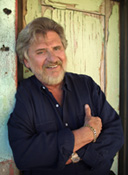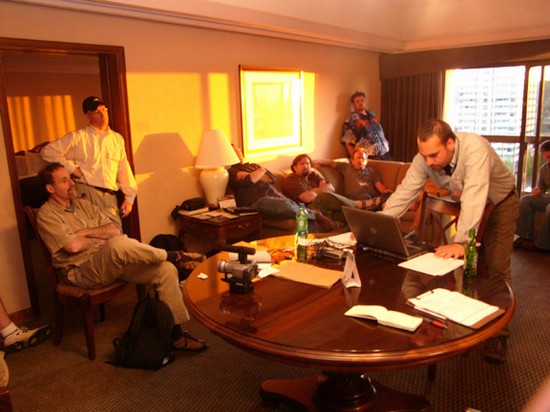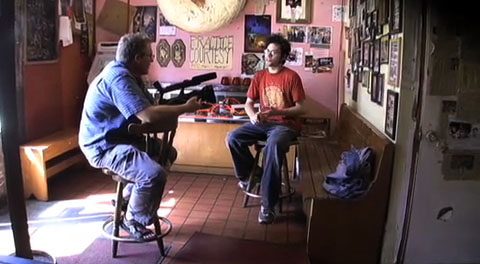 |
→ July 2007 Contents → Special Report
|
The NPPA Multimedia Immersion Workshop
July 2007
|
 |
|
It seemed like an impossible challenge.
To teach 40 photojournalists the art and technique of multimedia, taking them from novices to final project in just four days.
At the Platypus Workshops, of which we have conducted 19 over the past eight years, it took us nine days to teach 12 students these challenging skills.
Tony Overman, president of the National Press Photographers Association, told the students, "Last year we had the slogan, 'see the future and how to get there.' We knew you had to know multimedia in the future. You now HAVE to know this. You need to know it now! If you want to apply for a job at any newspaper you need multimedia samples."

NPPA Multimedia Immersion Workshop coordinator Seth Gitner meets with coaches in his hotel room in Portland, Ore., on the eve of the workshop.
Pointing to one of the students in the front row, Carolyn Cole of the Los Angeles Times, Overman said, "I don't want to embarrass you Carolyn, but she may be the best photographer in the business today, so when she signed up and said she wanted to learn this stuff, I thought that was amazing. It's what this program is all about."

Mark Hume of the Chicago Tribune does an interview with the owner of the "Voodoo Donuts" shop in Portland.
Instructors included Rich Beckman, professor of multimedia design at the University of North Carolina-Chapel Hill; David Leeson, executive producer of video and new media for The Dallas Morning News; Andrew DeVigal, multimedia editor for The New York Times; Jim Seida, multimedia producer for MSNBC; Richard Koci Hernandes, deputy director of multimedia and photography for the San Jose Mercury News; Joe Weiss, the creator of sound slides; Regina McCombs, multimedia director for the Minneapolis Star Tribune Online, and Judith Levitt, a multimedia producer for The New York Times.
There were two tracks for students to follow. One was to do still photographs and incorporate them into multimedia packages, using Soundtrack Pro; the other was to shoot video packages that they would edit with Final Cut Studio 2.

Regina McCombs of the Minneapolis StarTribune.com coaches a student during the editing sessions at the NPPA Immersion Workshop.
Simon Kerr and Mike Cutler from Canon guided the students as they unpacked their cameras, and familiarized them with how to use them. McCombs walked them through the basics of video journalism, Weiss led them through a two-hour session on how to use Aperture for editing their photographs, and Beckman led them through the complexities of editing in Final Cut Pro.
"You should break the story down into no more than three, maybe four major thoughts," Beckman told the rapt students. "It's going to take about 20 to 30 seconds to tell a little aspect of a story of a person's life, but it's going to take at least that long to get a complete 'video' thought across. So we think what clips we can use to best tell that story, and think about how we can sequence those best thoughts into a little story."

Los Angeles Times photographer Carolyn Cole uses her tiny Canon HV20 as she does a story on a homeless newspaper vendor on the streets of Portland.
"This is whole different language for me. I'm not used to this at all. I'm used to capturing moments and emotion. I'm basically running out of different ways to capture this man standing on a street corner."
Yet, 24 hours later, Carolyn had indeed put together an impressive short film. What's more important, it looked like Carolyn Cole had shot it.
We think she is ready for a Platypus Workshop. In fact, they all are!
© Dirck Halstead
Editor and Publisher of The Digital Journalist
|
|
Back to July 2007 Contents
|
|